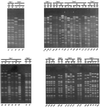Molecular epidemiology of Streptococcus uberis isolates from dairy cows with mastitis
- PMID: 11283072
- PMCID: PMC87955
- DOI: 10.1128/JCM.39.4.1460-1466.2001
Molecular epidemiology of Streptococcus uberis isolates from dairy cows with mastitis
Abstract
Pulsed-field gel electrophoresis and antimicrobial sensitivity testing were used as tools to investigate the epidemiology of Streptococcus uberis mastitis in dairy cows. A total of 62 different strains were found among 138 isolates from the four herds investigated, and between 10 and 26 different strains were found in each herd. There was no strain common to all four herds. Identical strains of S. uberis were detected from different quarters of individual cows and from cows within the same herd, suggesting that transmission from quarter to quarter and cow to cow had occurred. Despite the great variation in S. uberis strains, persistent infection with the same strain within a lactation was observed in most cows. Predominant strains were present in two herds. Preliminary investigations could not clarify why these particular strains might predominate, but in one herd there was a significant difference between the prevalence of clinical mastitis in quarters infected with the predominant strain and that in quarters infected with other strains, suggesting the greater virulence of the predominant strain. The wide variety of S. uberis strains found is consistent with an environmental source of S. uberis. However, evidence of direct transmission, the persistence of infection, and the predominance of particular strains in some herds indicate that S. uberis infections are epidemiologically complex and that the relative importance of these factors in the occurrence of mastitis may differ between herds.
Figures

Similar articles
-
Molecular Epidemiology of Streptococcus uberis Clinical Mastitis in Dairy Herds: Strain Heterogeneity and Transmission.J Clin Microbiol. 2016 Jan;54(1):68-74. doi: 10.1128/JCM.01583-15. Epub 2015 Oct 21. J Clin Microbiol. 2016. PMID: 26491180 Free PMC article.
-
Comparison of the population structure of Streptococcus uberis mastitis isolates from Austrian small-scale dairy farms and a Slovakian large-scale farm.J Dairy Sci. 2020 Feb;103(2):1820-1830. doi: 10.3168/jds.2019-16930. Epub 2019 Dec 16. J Dairy Sci. 2020. PMID: 31837784
-
Phenotypic and genotypic characterization of Streptococcus uberis isolated from bovine subclinical mastitis in Argentinean dairy farms.Rev Argent Microbiol. 2011 Jul-Sep;43(3):212-7. doi: 10.1590/S0325-75412011000300009. Rev Argent Microbiol. 2011. PMID: 22430996
-
An update on environmental mastitis: Challenging perceptions.Transbound Emerg Dis. 2018 May;65 Suppl 1:166-185. doi: 10.1111/tbed.12704. Epub 2017 Oct 30. Transbound Emerg Dis. 2018. PMID: 29083115 Review.
-
The exploitation of the genome in the search for determinants of virulence in Streptococcus uberis.Vet Immunol Immunopathol. 2004 Aug;100(3-4):145-9. doi: 10.1016/j.vetimm.2004.04.004. Vet Immunol Immunopathol. 2004. PMID: 15207452 Review.
Cited by
-
Multilocus Sequence Genotype Heterogeneity in Streptococcus uberis Isolated from Bovine Mastitis in the Czech Republic.Animals (Basel). 2022 Sep 7;12(18):2327. doi: 10.3390/ani12182327. Animals (Basel). 2022. PMID: 36139187 Free PMC article.
-
The Role of Streptococcus spp. in Bovine Mastitis.Microorganisms. 2021 Jul 13;9(7):1497. doi: 10.3390/microorganisms9071497. Microorganisms. 2021. PMID: 34361932 Free PMC article. Review.
-
A Novel Antimicrobial-Phytochemical Conjugate With Antimicrobial Activity Against Streptococcus uberis, Enterococcus faecium, and Enterococcus faecalis.Front Pharmacol. 2019 Nov 28;10:1405. doi: 10.3389/fphar.2019.01405. eCollection 2019. Front Pharmacol. 2019. PMID: 31849662 Free PMC article.
-
Genotyping and antimicrobial resistance of Streptococcus uberis isolated from bovine clinical mastitis.PLoS One. 2019 Oct 22;14(10):e0223719. doi: 10.1371/journal.pone.0223719. eCollection 2019. PLoS One. 2019. PMID: 31639136 Free PMC article.
-
Prevalence of bacterial genotypes and outcome of bovine clinical mastitis due to Streptococcus dysgalactiae and Streptococcus uberis.Acta Vet Scand. 2014 Nov 27;56(1):80. doi: 10.1186/s13028-014-0080-0. Acta Vet Scand. 2014. PMID: 25427658 Free PMC article.
References
-
- Almeida R A, Luther D A, Kumar S J, Calvinho L F, Bronze M S, Oliver S P. Adherence of Streptococcus uberis to bovine mammary epithelial cells and to extracellular matrix proteins. Zentbl Vetmed Reihe B. 1996;43:385–392. - PubMed
-
- Baseggio N, Mansell P D, Browning J W, Browning G F. Strain differentiation of isolates of streptococci from bovine mastitis by pulsed-field gel electrophoresis. Mol Cell Probes. 1997;11:349–354. - PubMed
-
- Bell S M. Antibiotic sensitivity testing by the CDS method. In: Hartwig N, editor. Clinical Microbiology Update Program—1984. Sydney, Australia: NSW Branch of the Australian Society for Microbiology; 1984.
-
- Bramley A J. Sources of Streptococcus uberis in the dairy herd. I. Isolation from bovine faeces and from straw bedding of cattle. J Dairy Res. 1982;49:369–373. - PubMed
-
- Buddle B M, Tagg J R, Ralston M J. Use of an inhibitor typing scheme to study the epidemiology of Streptococcus uberis mastitis. N Z Vet J. 1988;36:115–119. - PubMed
Publication types
MeSH terms
Substances
LinkOut - more resources
Full Text Sources
Other Literature Sources
Medical

